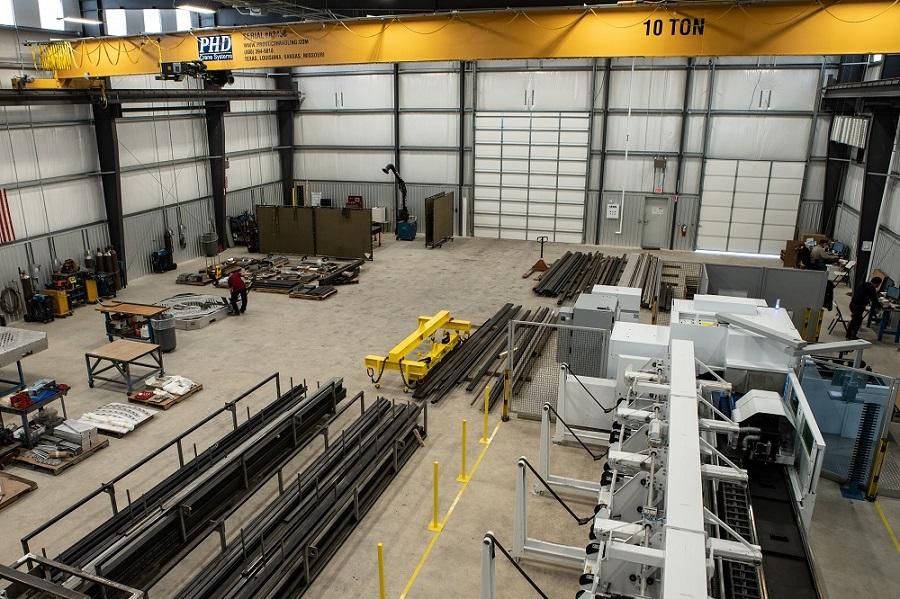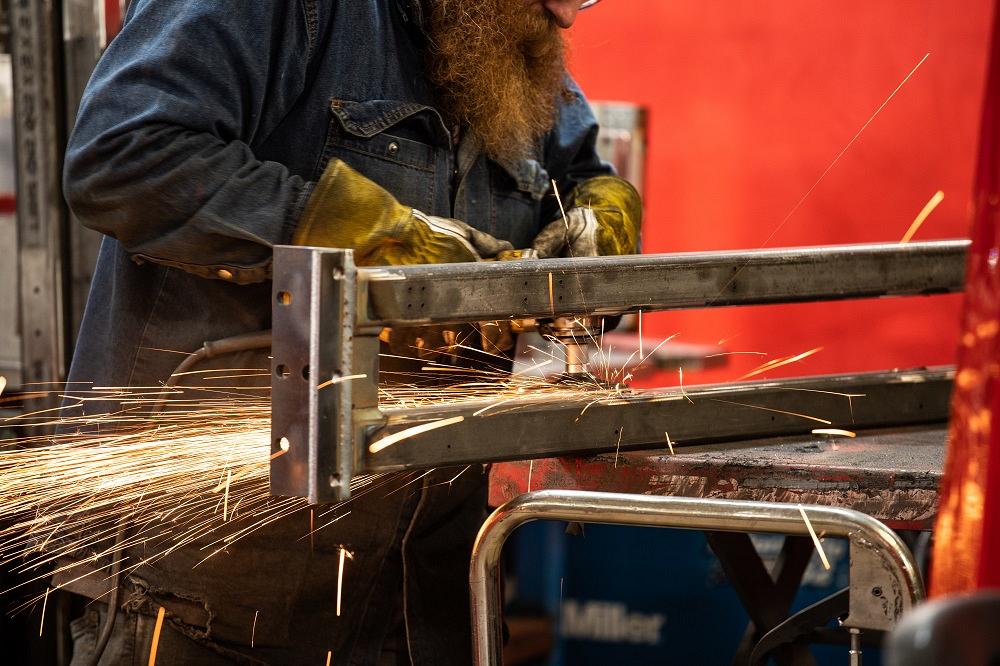Senior Editor
- FMA
- The Fabricator
- FABTECH
- Canadian Metalworking
Categories
- Additive Manufacturing
- Aluminum Welding
- Arc Welding
- Assembly and Joining
- Automation and Robotics
- Bending and Forming
- Consumables
- Cutting and Weld Prep
- Electric Vehicles
- En Español
- Finishing
- Hydroforming
- Laser Cutting
- Laser Welding
- Machining
- Manufacturing Software
- Materials Handling
- Metals/Materials
- Oxyfuel Cutting
- Plasma Cutting
- Power Tools
- Punching and Other Holemaking
- Roll Forming
- Safety
- Sawing
- Shearing
- Shop Management
- Testing and Measuring
- Tube and Pipe Fabrication
- Tube and Pipe Production
- Waterjet Cutting
Industry Directory
Webcasts
Podcasts
FAB 40
Advertise
Subscribe
Account Login
Search
Texas shop reaches beyond the contract manufacturing sandbox
Machine shop and fabricator becomes a contract manufacturing-OEM hybrid
- By Tim Heston
- November 19, 2020
- Article
- Materials Handling

A worker pulls a Eurostorage drawer, rated to hold up to 1 ton of material. Drawers can be designed to hold up to 3 tons each.
On Nov. 1 Athena Manufacturing celebrated its 20th year, and the business has evolved significantly since its beginnings as a small machine shop in Austin, Texas. It’s now a 200-plus-employee metal manufacturer: part machine shop, part custom sheet metal fabricator, part tube fabricator, part OEM.
Athena’s story shows how adaptable a manufacturing business can be. Just because a manufacturer starts as a machine shop doesn’t mean it needs to stay in that sandbox. Similarly, just because a business is a job shop doesn’t mean it can’t be an OEM.
Following Opportunity
In late 1998 two entrepreneurs, Bill Johnson and John Newman, sold a machining and fabrication operation, and in November 2000 they put their chips back on the table and launched Athena as a machine shop. A year later the company added sheet metal fabrication. After that came welding, powder coating, and silk screening. The company is in the heart of the Texas semiconductor industry, from which Athena added a broad range of aerospace, military, and general industry clients.
For flat sheet cutting, the company has an Amada punch/laser combo with automatic loading and part stacking, an Amada 4-kW laser with a rotary index, and a ShopSabre flatbed router.
Why adapt such a diverse process mix right off the bat? “Because of the semiconductor business in and around Austin, there’s a lot of manufacturing opportunities that call for fabrication, welding, and machining, so it’s a business model adapted by many contract manufacturers in the area,” said Johnson, Athena’s president. (Newman, Johnson’s business partner, is CFO.) He added that among its top machining “customers” is Athena itself. In other words, many machined parts go into sheet metal and tubular assemblies.
Already heavy into tubular frame manufacturing, the company ramped up capacity in December 2018 when it opened a 10,000-sq.-ft. building on the same property. By the next spring a new TRUMPF 5-axis tube laser was cutting workpieces with outside diameters up to 6.00 in.
The machine accepts tubes up to 25 ft. long. Still, managing such long raw material requires careful planning. How will the tube be unloaded and stored before being placed on the machine’s feeding unit? The process can be lengthy and cumbersome, especially if the tube must rotate after being unloaded from the delivery truck.
At Athena, though, operations managers probably don’t cringe when needing to manipulate a 25-ft. stick of tubing. That’s because the entire building was designed with efficient material handling in mind. The delivery trailer backs into the shop and a bridge crane unloads tubing onto a racking system parallel to the trailer. The tube laser, conveniently, is also parallel to the material rack: no need to rotate tubes 90 degrees.
Within the next few months, the company plans to replace its existing tube racking system with a cantilever rack with individually extendible drawers that can be moved by a single operator. The concept comes from a company called Eurostorage, a Belgian operation that has a close relationship with Athena. That relationship is why Athena isn’t just a job shop and contract manufacturer. It’s also an OEM.
On Being an OEM
It’s not unusual for contract manufacturers to delve into some level of product-line manufacturing—not just parts or subassemblies, but completed products delivered directly to the end user. Some might fabricate private-label products for which the customer handles the marketing, sales, perhaps some level of distribution, and the product design. The customer also might work with the contract fabricator on manufacturability, but when it comes to the product’s design, the customer has the final say.
At the other end of the spectrum, a job shop might launch its own product. It has complete design freedom; owns the intellectual property; and handles the sales, marketing, distribution, and, of course, all the manufacturing.
For about 10 years Athena has manufactured a family of avionics and power distribution enclosures for a large aircraft OEM. The line of work falls in the middle of the spectrum. It’s like a private-label arrangement in that Athena purchases components, fabricates, assembles, and ships products directly to the end user. But unlike typical private-label work, Athena has control over the product design, at least within a set of preestablished specifications. Athena also has a similar relationship with a local exercise equipment OEM.
Having design control calls for a far more robust engineering department. “It’s very different from the build-to-print world,” Johnson said. “When you have design control, your engineering department has expanded responsibilities and a much higher work load.”
Keep the Material Moving
Several years ago, Johnson and Newman needed to find a better way to handle sheet metal, plate, and tube. By that point Athena had already invested significantly in automation. In the machine shop, a robot tends a DMG 5-axis mill; a 24-pallet system feeds a lights-out Makino machining cell; and another 10-pallet system feeds two 5-axis Grob mills. Its lasers have load/unload systems, and its punch/laser combo is equipped with automated sheet loading and parts stacking. And a Miller/Panasonic robot welding station generates a steady flow of weldments through its two workstations.
To store raw sheet and plate, Johnson didn’t want to dedicate the floor space to an expansive automated storage and retrieval system, but the shop’s conventional racking still wasn’t very efficient. Working in both the aerospace and semiconductor sectors calls for a wide range of material types and thicknesses, and Athena keeps more than 50 sheet types on the floor. Remnant management was also important, mainly for expensive material. The company needed a reliable, organized way to store (and correctly enter into the ERP system) remnants without disrupting production.
If a programmer nests a group of parts, then finds that he can’t fill a sheet, he might fill the rest of the sheet by adding regularly scheduled parts or parts needed for future jobs farther out in the schedule. Alternatively, the remnant might be sent to the recycle bin. And sure, this strategy might work fine for inexpensive thin carbon steel, but not for aerospace stainless or titanium. Cutting extra filler parts for later use just isn’t an option, and even a small remnant is too expensive to throw in the recycle bin.
Looking for an alternative, the company found Eurostorage. The racks allow one person to pull out a heavily loaded drawer—oriented horizontally or vertically—full of sheet metal, tube, plate, bar, or other shapes. After extending the drawer, the same person can retrieve the needed material with a crane, stage it at a production machine, or put it directly on the machine table.
Seeing all this, Johnson called Eurostorage’s Belgium headquarters, outside Ghent. The call could have been very short. Yes, the storage systems were great; unfortunately, they were expensive to ship across the pond.
But the call wasn’t short. In fact, before long Johnson was talking with Eurostorage founder Geert Desmedt. It turned out that Eurostorage was looking for a North American marketing, sales, and manufacturing partner.
Johnson deliberated, but the timing wasn’t right. “At the time, we just didn’t have the resources to tackle a project like this.”

Athena opened its tube cutting facility in 2018. Traveling from the truck bed to the rack to the tube laser magazine, material remains in the same orientation.
It was 2017. Athena was about to build an additional facility for its tube laser. Moreover, such a licensing agreement would move Athena into new territory: OEM direct sales and marketing.
To Europe
By late 2018 the situation had changed. The tube laser would soon be up and running, which would streamline tubular fabrication with integrated drilling/tapping, tab-and-slot assembly, and part number etching. The time was right to make the leap.
Johnson and Newman headed to Belgium, and over the next several months the company negotiated an agreement. Eurostorage would own the intellectual property, including unique design components that effectively make a material storage rack a “Eurostorage” rack—in other words, “how the material is presented to the human,” Johnson said. Outside this, and as long as the product meets stringent safety standards, Athena’s engineering team would have the freedom to tailor designs for the North American market.
Selling During a Pandemic
“The selling process is unique. It takes significant analysis and a lot of fact-finding.”
So said Kyle Boatright, Athena’s sales and marketing manager for the Eurostorage product line. The consultative sales approach involves factors like the mix of material, its dimensions and weight; the ceiling height; the material handling devices used (such as a bridge crane or jib crane), their lifting capacities, and their end effectors (hooks, chains, vacuum cups, magnetic lifts, etc.); the available space; fork truck traffic (including traffic that could be eliminated); and, not least, where the rack will be in relation to the material destination.
The racks themselves are simple, but integrating them into an error-free, efficient process isn’t quite so straightforward. Boatright described it as a kind of “material handling ballet,” where every move can lead to less time before the next value-adding operation (like laser cutting) takes place.
“Transportation” is a classic waste in lean manufacturing. In lean parlance, every waste has necessary and unnecessary components. It’s “necessary” for material to be transported from the rack to the machine, but what components of that material handling ballet could—with a certain rack configuration—be made unnecessary and, hence, eliminated? Athena has performed this “ballet analysis” many times over its 20-year history, and that experience has helped Boatright communicate material handling strategies to various manufacturers with disparate challenges.
“When discussing horizontal cassette forklift racks, we even get into details about forklifts,” Johnson said. “How tall is your tallest forklift, and how tall is your ceiling? The maximum height of a Eurostorage cassette rack is often determined by the forklift, not the ceiling height.”
During normal times, a rack investment would call for a plant visit. Of course, when the pandemic hit and the lockdown ensued, plant visits haven’t been feasible. Still, Boatright has made good use of Zoom and has had many shop floor video tours.
But there’s a silver lining: The situation has forced the company to look at an alternative way of selling that, even after the pandemic, could make the entire process more efficient. Boatright uses a decision matrix, with inputs such as raw material dimensions, alloy, and quantity; the current method of material loading/unloading; factory flow (including the type and availability of overhead cranes); available space for material storage; and available under-hook height.
This decision matrix is being automated. “The software will generate a plan-view scale drawing, and the customer will see his or her warehouse or factory floor,” Johnson said, adding that the matrix will help answer various questions. “How are you going to get the material inside? For long tubing, can you avoid vertical axis rotation of the material? Does vertical or horizontal storage work best, or both? Are there remnants, and if so, how do they get returned to storage and where?”
Idiosyncrasies of a Custom Product Line
A custom fabricator that launches its own product often does so to help even out the relatively unpredictable demand in contract manufacturing. To do this, it chooses a product line with little variation and relatively predictable demand. When times are slow, the fabricator can produce its product line to stock (up to a certain level). And in the cutting operation, product components can be useful filler parts when the programmer needs to fill out a nest.
Athena’s situation, though, is different. The Eurostorage line consists largely of configure-to-order products. Some smaller, common elements like machined bushings and roller wheels can indeed be made to stock. But just as every shop is different, every rack is different too. Hence, Athena must limit its finished goods inventory.
From a work flow perspective, the sales process—including the prospecting and information-gathering—is the most time-consuming. But once Athena has the information it needs, it’s off to the races. Eurostorage components can be engineered quickly based on a modular framework. And, of course, every component is made for ease of manufacturability, with the company’s equipment and tooling in mind.
The Shop Floor Perspective
Athena has had a formal continuous improvement program in place for more than a decade. In fact, improvement initiatives are what drew the company to Eurostorage products in the first place.
As any lean practitioner will preach, value happens on the shop floor. So from the shop floor worker’s perspective, what separates OEM work from contract jobs at Athena? As Johnson explained, “It’s about the sphere of influence. Does [the job] also include the design of the part or just the manufacture of the part?”
Although Athena does offer manufacturability suggestions to its contract customers, most require the part to be fabricated as designed, usually because of all the required engineering approvals. So the design is fixed, and the part is built to print.
“The sphere of influence encompasses the manufacturing process only, so creativity, design, and innovation for these jobs occur in the manufacturing realm, resulting in [new] fixture designs, tooling, and toolpaths,” Johnson said. “While the shop floor workers’ continuous improvement ideas cannot include changing the part design, their ideas can nevertheless make significant improvements in part quality and cost.”
For the Eurostorage line and, for that matter, any customer that gives Athena design control, “the sphere of influence encompasses the entire product life cycle, starting with a tight collaboration between sales and engineering,” Johnson said. Designs take manufacturability into account from the get-go, tailored to the company’s equipment and expertise.
“While the actual machining and fabrication are intentionally straightforward, the shop floor worker knows his continuous improvement ideas can include possible design improvements,” Johnson continued. “So now the design team gets the shop floor perspective in real time, which drives continuous improvement and creativity to a new level.”
From Athena the contract manufacturer, customers buy capacity and manufacturing expertise. From Athena the OEM, customers buy the product. Having both brings diversity not only in the markets the company serves, but also in the workday itself. At Athena, those who enjoy monotony need not apply.
About the Author

Tim Heston
2135 Point Blvd
Elgin, IL 60123
815-381-1314
Tim Heston, The Fabricator's senior editor, has covered the metal fabrication industry since 1998, starting his career at the American Welding Society's Welding Journal. Since then he has covered the full range of metal fabrication processes, from stamping, bending, and cutting to grinding and polishing. He joined The Fabricator's staff in October 2007.
Related Companies
subscribe now

The Fabricator is North America's leading magazine for the metal forming and fabricating industry. The magazine delivers the news, technical articles, and case histories that enable fabricators to do their jobs more efficiently. The Fabricator has served the industry since 1970.
start your free subscription- Stay connected from anywhere

Easily access valuable industry resources now with full access to the digital edition of The Fabricator.

Easily access valuable industry resources now with full access to the digital edition of The Welder.

Easily access valuable industry resources now with full access to the digital edition of The Tube and Pipe Journal.
- Podcasting
- Podcast:
- The Fabricator Podcast
- Published:
- 04/30/2024
- Running Time:
- 53:00
Seth Feldman of Iowa-based Wertzbaugher Services joins The Fabricator Podcast to offer his take as a Gen Zer...
- Trending Articles
JM Steel triples capacity for solar energy projects at Pennsylvania facility

Fabricating favorite childhood memories

How laser and TIG welding coexist in the modern job shop

Robotic welding sets up small-batch manufacturer for future growth

Ultra Tool and Manufacturing adds 2D laser system

- Industry Events
Pipe and Tube Conference
- May 21 - 22, 2024
- Omaha, NE
World-Class Roll Forming Workshop
- June 5 - 6, 2024
- Louisville, KY
Advanced Laser Application Workshop
- June 25 - 27, 2024
- Novi, MI
Precision Press Brake Certificate Course
- July 31 - August 1, 2024
- Elgin,





























